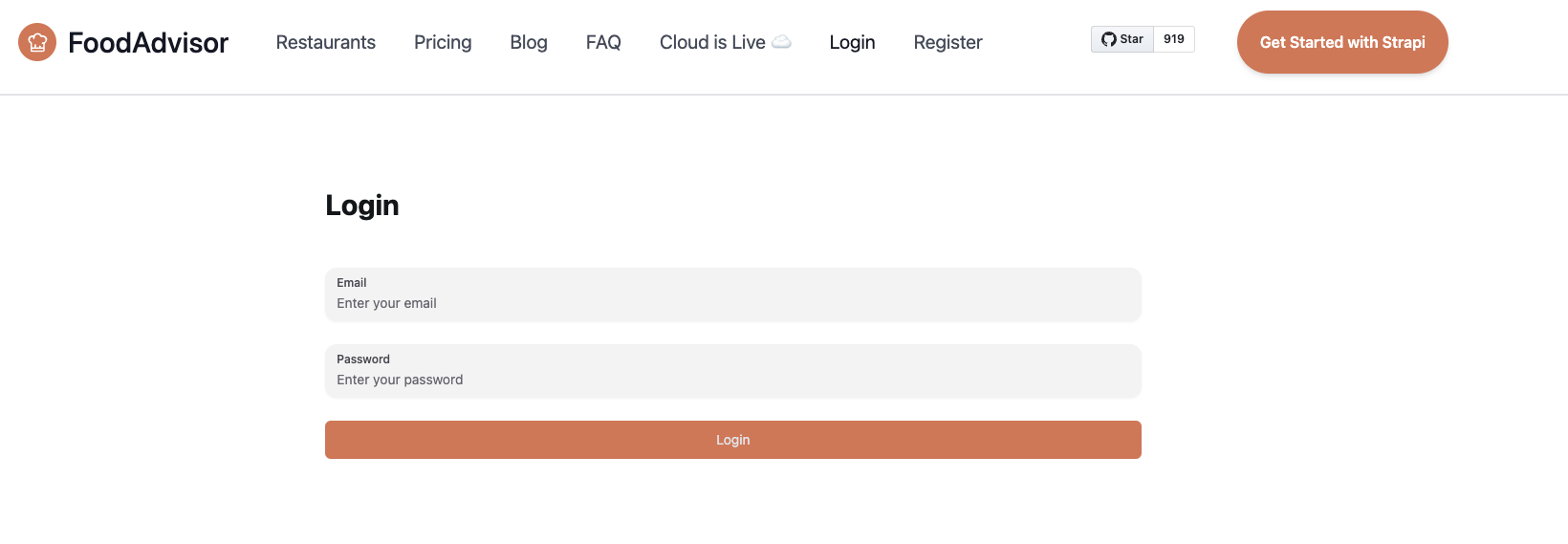示例手册:使用 JWT 的身份验证流程
此页面是后端自定义示例手册的一部分。请确保您已阅读其 简介。
💭 上下文:
开箱即用,FoodAdvisor 的前端网站不提供任何登录功能。登录是通过访问 localhost:1337/admin 上的 Strapi 管理面板完成的。
让我们在前端添加一个基本的登录页面,这个由 Next.js 提供支持的网站包含在 FoodAdvisor 的 /client 文件夹中。登录页面可通过 localhost:3000/auth/login 访问,并包含一个典型的电子邮件/密码登录表单。这将允许以编程方式验证发送到 Strapi 的 API 请求。

🎯 目标:
创建一个前端组件以:
- 显示登录表单,
- 向 Strapi 后端服务器的
/auth/local路由发送请求以进行身份验证, - 获取 JSON Web Token (JWT),
- 并将 JWT 存储到浏览器的
localStorage属性,以便稍后检索和验证我们的请求。
有关 JWT 身份验证的其他信息,请参阅 用户和权限插件 文档。
🧑💻 代码示例:
本节中的代码示例使用 formik 包。使用 yarn add formik 或 npm install formik 安装它并重新启动开发服务器。
为此,在 FoodAdvisor 项目的 /client 文件夹中,您可以创建一个包含以下示例代码的 pages/auth/login.js 文件。突出显示的行显示发送到 Strapi 的用户和权限插件提供的 /auth/local 路由的请求:
/client/pages/auth/login.js
jsx
import React from 'react'
import { useFormik } from 'formik'
import { Button, Input } from '@nextui-org/react'
import Layout from '@/components/layout'
import { getStrapiURL } from '@/utils'
function Login() {
const { handleSubmit, handleChange } = useFormik({
initialValues: {
identifier: '',
password: '',
},
onSubmit: async (values) => {
/**
* API URLs in Strapi are by default prefixed with /api,
* but because the API prefix can be configured
* with the rest.prefix property in the config/api.js file,
* we use the getStrapiURL() method to build the proper full auth URL.
*/
const res = await fetch(getStrapiURL('/auth/local'), {
method: 'POST',
headers: {
'Content-Type': 'application/json',
},
body: JSON.stringify(values),
})
/**
* Gets the JWT from the server response
*/
const { jwt } = await res.json()
/**
* Stores the JWT in the localStorage of the browser.
* A better implementation would be to do this with an authentication context provider
* or something more sophisticated, but it's not the purpose of this tutorial.
*/
localStorage.setItem('token', jwt)
},
})
/**
* The following code renders a basic login form
* accessible from the localhost:3000/auth/login page.
*/
return (
<Layout>
<div className="h-full w-full flex justify-center items-center my-24">
<form onSubmit={handleSubmit} className="flex flex-col gap-y-6 w-4/12">
<h1 className="font-bold text-3xl mb-6">Login</h1>
<Input
onChange={handleChange}
type="email"
name="identifier"
label="Email"
placeholder="Enter your email"
/>
<Input
type="password"
name="password"
label="Password"
placeholder="Enter your password"
onChange={handleChange}
/>
<Button type="submit" className="bg-primary rounded-md text-muted">
Login
</Button>
</form>
</div>
</Layout>
)
}
export default Login
Learn more about how custom services and controllers can help you tweak a Strapi-based application.